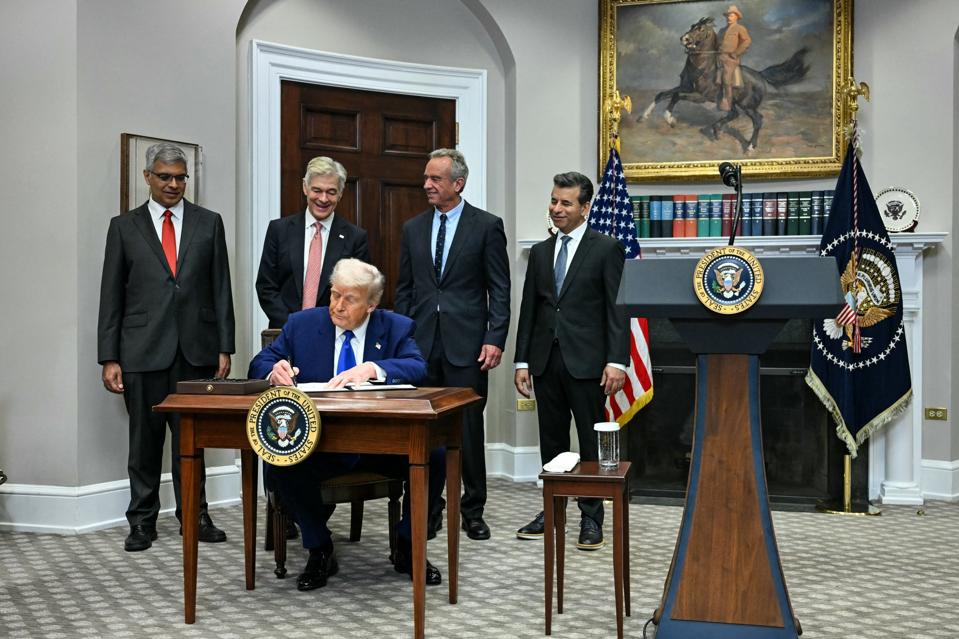President Trump’s groundbreaking trip to the Middle East overshadowed the news of his EO on drug pricing at the start of the week. On May 12, Trump made his perspective on the current state of pharmaceutical pricing crystal clear. He said that other developed countries, most notably the EU, have used access to their markets to drive drug prices so far below those that Americans pay for the same products that the anti-competitive aspects of the situation need to be rectified.
The EO states that Americans should no longer be forced to subsidize low-cost prescription drugs or biologics in other countries while facing ‘overcharges’ for the same products in the U.S. Moving forward, American consumers will have access to the ‘most-favored nation’ price for these medicines. To achieve the objective, the EO lays out a whole of government approach starting with three broad actions: 1) addressing foreign nations “freeloading” on American-financed innovation, 2) enabling direct-to-consumer sales to American patients at the most-favored-nation price, and 3) establishing MFN pricing.
By starting with the problem of international freeloading, the EO redefined the boundaries of the problem from a drug pricing problem in the U.S. to an international commerce issue. The EO stated that the secretary of Commerce and the U.S. trade representative can take action against other countries whose trade practices regarding drugs “may be unreasonable or discriminatory.” The implicit assumption is that some significant portion of the high prices Americans pay for drugs is attributable to the anticompetitive practices of other nations. In other words, others around the globe are not paying their fair share and taking advantage of American generosity and innovation.
Trump used his press conference to highlight powerful examples of what a path forward might include and the levers he was ready to pull to achieve his objectives. He pointed out, for example, that German car exports to the U.S. reflect robust trade. To the extent that Germany’s importation of U.S. pharmaceuticals disadvantages pharma manufacturers, he said he would be open to looking at how the U.S. imports German cars. And he noted, parenthetically, how much he values the U.S. pharmaceutical sector.
The Secretary of Health and Human Services was tasked with facilitating direct-to-consumer purchasing of drugs at MFN pricing. While no details were provided, the implications of this could be far-reaching. It sets the stage for easier access to medications and paves the way to cut out the “middlemen,” a group Trump described as adding questionable value to healthcare that doesn’t manufacture anything.
Within 30 days of the EO, the secretary of HHS, the administrator of the Centers for Medicare and Medicaid Services, and relevant others were directed to establish MFN price targets and communicate these to manufacturers. In the event that progress towards MFN pricing is not delivered, the EO directs the secretary to propose a rulemaking plan to impose MFN pricing on manufacturers and consider importation of select drugs. The EO also directs the commissioner of the Food and Drug Administration to “review and potentially modify or revoke approvals” for drugs in the event there is evidence they may be “unsafe, ineffective, or improperly marketed.”
Included in this clause is direction to the attorney general and chairman of the Federal Trade Commission to take “enforcement action against any (identified) anti-competitive practices” that have been exposed in relevant program analyses. This ties back to a prior EO and reflects a clear warning to pharmacy benefit managers and insurers that the administration is serious about challenging such practices. The EO also directs the secretary of Commerce and others to review and take action to address global price discrimination issues.
Some industry insiders have dismissed the EO because it did not detail specific actions and timeframes. Others dismissed it because those actions that were detailed, particularly related to MFN, were deemed unrealistic. The EO gives these agencies far-reaching license to initiate investigations and issue new rules that will be binding.
The EO lays out a framework for resetting the global playing field and ending the imbalance that has long characterized the price of pharmaceuticals. Unlike some other proposed solutions which have put the entire onus of the problem on pharma, Trump’s EO also recognizes that the boundaries of the problem are bigger than pharma, bigger than the U.S., and bigger than drug prices per se. That concept is revolutionary and can pave the way for a more equitable global approach to pharmaceutical pricing. And that is good news for the American consumer.

